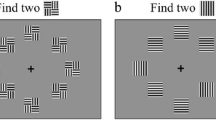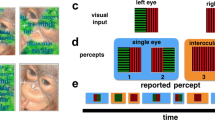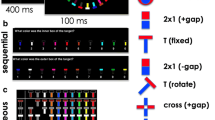Abstract
We apply the competitive model of Loxley and Robinson (Phys Rev Lett 102:258701, 2009. doi:10.1103/PhysRevLett.102.258701) to the study of a special case of visual rivalry. Three-peaked inputs with maxima at symmetrical locations are introduced, and the role of three-bump configurations is then considered. The model yields conditions for what can be interpreted as a bistable percept analogous to the one-dimensional version of a competition between the central and flanking parts of an image.
















Similar content being viewed by others
References
Amari S (1977) Dynamics of pattern formation in lateral-inhibition type neural fields. Biol Cybern 27:77–87
Andrews TJ, Schluppeck D, Homfray D, Matthews P, Blakemore C (2002) Activity in the fusiform gyrus predicts conscious perception of Rubin’s vase-face illusion. NeuroImage 17:890–901. doi:10.1006/nimg.2002.1243
Attneave F (1971) Multistability in perception. Sci Am 225:61–71
Blake R (1989) A neural theory of binocular rivalry. Psychol Rev 96:145–167
Blake R, Logothetis NK (2002) Visual competition. Nat Rev Neurosci 3:13–21
Blake R, Wilson H (2011) Binocular vision. Vis Res 51:754–770
Bressloff PC (2005) Spontaneous symmetry breaking in self-organizing neural fields. Biol Cybern 93:256–274. doi:10.1007/s00422-005-0002-3
Bressloff PC, Coombes S (2013) Neural bubble dynamics revisited. Cogn Comput 5:281–294. doi:10.1007/s12559-013-9214-3
Compte A, Brunel N, Goldman-Rakic P, Wang X-J (2000) Synaptic mechanisms and network dynamics underlying spatial working memory in a cortical network model. Cereb Cortex 10:910–923
Coombes S, Owen MR (2004) Evans functions for integral neural field equations with Heaviside firing rate function. SIAM J Appl Dyn Syst 34:574–600
Coombes S, Owen MR (2005) Bumps, breathers, and waves in a neural network with spike frequency adaptation. Phys Rev Lett 94:148102
Coombes S, Owen MR (2007) Exotic dynamics in a firing rate model of neural tissue with threshold accommodation. Contemp Math 440:123–144
Ermentrout GB, Terman D (2010) Foundations of mathematical neuroscience. Interdisciplinary applied mathematics. Springer, Berlin
Folias EE, Bressloff PC (2004) Breathing pulses in an excitatory neural network. SIAM J Appl Dyn Syst 3:378–407
Huguet G, Rinzel J, Hupé J-M (2014) Noise and adaptation in multistable perception: noise drives when to switch, adaptation determines percept choice. J Vis 14:1–24. doi:10.1167/14.3.19
Izhikevich EM (2007) Dynamical systems in neuroscience: the geometry of excitability and bursting. MIT Press, Cambridge
Kilpatrick ZP, Bressloff PC (2010) Spatially structured oscillations in a two-dimensional excitatory neuronal network with synaptic depression. J Comput Neurosci 28:193–209. doi:10.1007/s10827-009-0199-6
Kilpatrick ZP (2013) Short term synaptic depression improves information transfer in perceptual multistability. Front Comput Neurosci 7(85):1–16. doi:10.3389/fncom.2013.00085
Lago-Fernández LF, Deco G (2002) A model of binocular rivalry based on competition in IT. Neurocomputing 44:503–507
Laing CR, Chow CC (2002) A spiking neuron model for binocular rivalry. J Comput Neurosci 12:39–53
Laing CR, Troy WC, Gutkin B, Ermentrout GB (2002) Multiple bumps in a neuronal model of working memory. SIAM J Appl Math 63:62–97
Laing CR, Troy WC (2003) Two-bump solutions of Amari-type models of neuronal pattern formation. Physica D 178:190–213
Laing CR (2014) Numerical bifurcation theory for high-dimensional neural models. J Math Neurosci 4:13. doi:10.1186/2190-8567-4-13
Lehky SR (1988) An astable multivibrator model of binocular rivalry. Perception 17:215–228
Loxley PN, Robinson PA (2007) Energy approach to rivalry dynamics, soliton stability, and pattern formation in neuronal networks. Phys Rev E 76:046224. doi:10.1103/PhysRevE.76.046224
Loxley PN, Robinson PA (2009) Soliton model of competitive neural dynamics during binocular rivalry. Phys Rev Lett 102:258701. doi:10.1103/PhysRevLett.102.258701
Matsuoka K (1984) The dynamic model of binocular rivalry. Biol Cybern 49:201–208
Matsuoka K (1985) Sustained oscillations generated by mutually inhibiting neurons with adaptation. Biol Cybern 52:367–376
Moreno-Bote R, Rinzel J, Rubin N (2007) Noise-induced alternations in an attractor network model of perceptual bistability. J Neurophysiol 98:1125–1139. doi:10.1152/jn.00116.2007
Naber M, Gruenhage G, Einhäuser W (2010) Tri-stable stimuli reveal interactions among subsequent percepts: rivalry is biased by perceptual history. Vis Res 50:818–828. doi:10.1016/j.visres.2010.02.004
Necker L (1832) Observations on some remarkable optical phenomena seen in Switzerland, and on an optical phenomenon which occurs on viewing a figure of a crystal or geometrical solid. Lond Edinb Philos Mag J Sci 1:329–337
Ngo TT, Liu GB, Tilley AJ, Pettigrew JD, Miller SM (2008) The changing face of perceptual rivalry. Brain Res Bull 75:610–618. doi:10.1016/j.brainresbull.2007.10.006
Orbach J, Zucker E, Olson R (1966) Reversibility of the Necker cube VII. Reversal rate as a function of figure-on and figure-off durations. Percept Mot Skills 17:439–458
Owen MR, Laing CR, Coombes S (2007) Bumps and rings in a two-diemensional neural field: splitting and rotational instabilities. New J Phys 9:378–401
Rankin J, Meso AI, Masson GS, Faugeras O, Kornprobst P (2014) Bifurcation study of a neural field competition model with an application to perceptual switching in motion integration. J Comput Neurosci 36:193–213. doi:10.1007/s10827-013-0465-5
Romeo A, Supèr H. (2017) Bump competition and lattice solutions in two-dimensional neural fields. Neural Netw 94:141–158. doi:10.1016/j.neunet.2017.07.003
Rubin E (2001) Visuell wahrgenommene Figuren, Gyldendals, Copenhagen (1921)
Rubin N (2001) Figure and ground in the brain. Nat Neurosci 4:857–858. doi:10.1038/nn0901-857
Rubin N (2003) Binocular rivalry and perceptual multi-stability. Trends Neurosci 26:289–291
Shpiro A, Moreno-Bote R, Rubin N, Rinzel J (2009) Balance between noise and adaptation in competition models of perceptual bistability. J Comput Neurosci. doi:10.1007/s10827-008-0125-3
Supèr H, Romeo A, Keil M (2010) Feed-forward segmentation of figure-ground and assignment of border-ownership. PLoS ONE 5:e10705. doi:10.1371/journal.pone.0010705
Suzuki S, Grabowecky M (2002) Evidence for perceptual ’trapping’ and adaptation in multistable binocular rivalry. Neuron 36:143–157
Wallis G, Ringelhan S (2013) The dynamics of perceptual rivalry in bistable and tristable perception. J Vis 13:1–21. doi:10.1167/13.2.24
Wang M, Arteaga D, He BJ (2013) Brain mechanisms for simple perception and bistable perception. PNAS. doi:10.1073/pnas.1221945110
Wimmer K, Nykamp DQ, Constantinidis C, Compte A (2014) Bump attractor dynamics in prefrontal cortex explains behavioral precision in spatial working memory. Nat Neurosci 17(17):431–439. doi:10.1038/nn.3645
Acknowledgements
This work was supported by a Grant (PSI2014-57454-P) from the Spanish Government to H.S. The authors wish to thank Profs. Peter N. Loxley and Peter A. Robinson for valuable comments and observations and also the anonymous referees of the earlier versions of this work for their useful suggestions.
Author information
Authors and Affiliations
Corresponding author
A Appendix: stability criterion
A Appendix: stability criterion
Stability is often studied by application of the Evans technique (see [10,11,12, 26] and refs therein), assuming that time-dependent deviations from the stationary solutions \(u_s(x)\), \(\theta _s(x)\) have the form
where \(\delta u\), \(\delta \theta \) are regarded as small magnitudes. Inserting (3), (12) into (1), one can expand the resulting expressions to first order in \(\delta u\), \(\delta \theta \). Such an expansion is performed with the help of the formal rule \(\displaystyle {\delta \over \delta g(z)}\Theta \left( g(z) \right) = \delta _\mathrm{D}( g(z) )= {1 \over |g'(z)|} \delta _\mathrm{D}(z), \) valid inside integrals, where \(\delta _\mathrm{D}\) denotes Dirac’s delta. This procedure enables us to factor out the time dependence and obtain a set of \(4N_s\) equalities no longer t-dependent, just x-dependent. Next, we consider as specific x values the boundary points themselves
For the particular values \(x= x_i\), \(i=1,\dots , 2N_s\), those general equalities reduce to a set of equations which can be arranged into the form
with
\(\widehat{\mathcal {D}}_f(\lambda )\equiv \tau _f\lambda +1\), \(\widehat{\mathcal {D}}_s(\lambda )\equiv \tau _s\lambda +1\). \(I_{2N_s}\) is the \(2N_s \times 2N_s\) identity matrix and \(\mathcal {A}\) is a \(2N_s \times 2N_s\) matrix with coefficients
where the \(x_i\)’s and \(x_j\)’s are the region limits in the notation (13). The denominators are easily obtained from (3) which, after differentiation w.r.t. the only present argument, supply
Existence of nontrivial solutions to system (14) requires \(\det (\mathcal {M})= 0\). (This is often—perhaps not quite correctly—called ‘eigenvalue equation’ because, like in a true eigenvalue problem, the solutions are the different values of a scalar parameter which cause a determinant to vanish.) Further, by virtue of the block structure of \(\mathcal {M}\), its determinant amounts to
Moreover, for \(\widehat{\mathcal {D}}_s(\lambda )-\kappa \ne 0\), it is possible to divide by \(\widehat{\mathcal {D}}_s(\lambda )-\kappa \) and, doing as the authors of Ref. [26] did, we can just study the zeros of the following Evans function
In the ‘Evans sense’, stability of the \(u_s\), \(\theta _s\) solutions requires that all the \(\lambda \)’s satisfying \(\mathcal {E}(\lambda )= 0\) have Re\((\lambda ) < 0\). This criterion is easy to understand by recalling the form of the Ansatz (12) and realizing how the character of \(\lambda \) determines the qualitative nature of the deviations of u and \(\theta \) from \(u_s\) and \(\theta _s\), respectively.
Note that by (19) and relations (16), (17), the Evans function \(\mathcal {E}(\lambda )\) depends, through the presence of the \(\mathcal {A}\) matrix, on the form of the particular h(x), \(h'(x)\). Furthermore, because this matrix also depends directly on the found centres and widths—the \(a_i\), \(m_i\), \(1 \le i \le N_i\)—the shape of every possible Evans function is determined by these particular values as well.
Rights and permissions
About this article
Cite this article
Romeo, A., Supèr, H. ‘Two vs one’ rivalry by the Loxley–Robinson model. Biol Cybern 111, 405–420 (2017). https://doi.org/10.1007/s00422-017-0734-x
Received:
Accepted:
Published:
Issue Date:
DOI: https://doi.org/10.1007/s00422-017-0734-x




